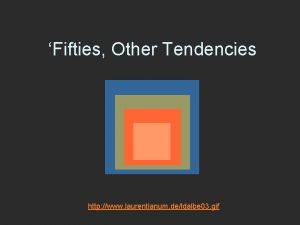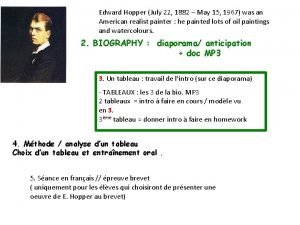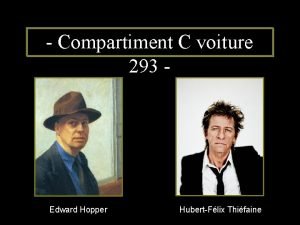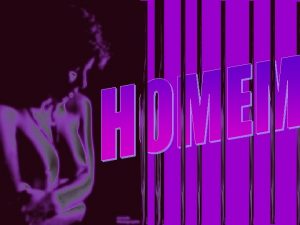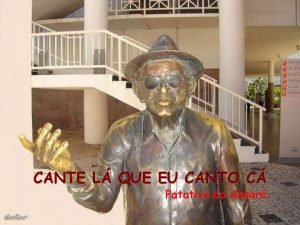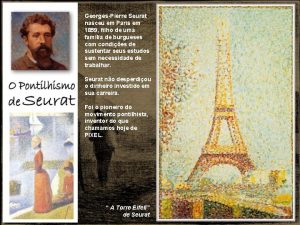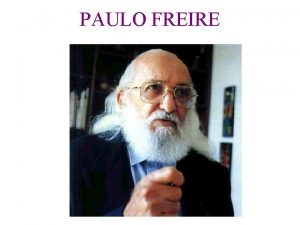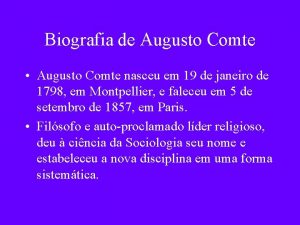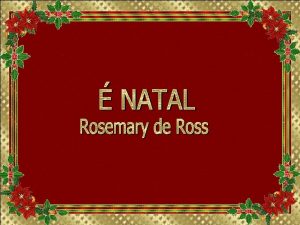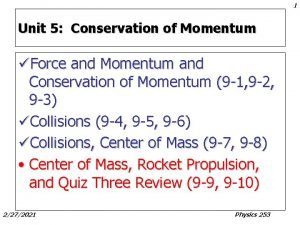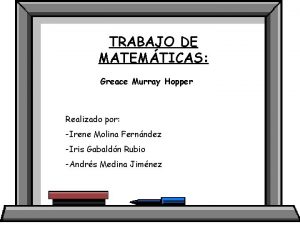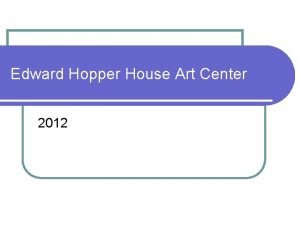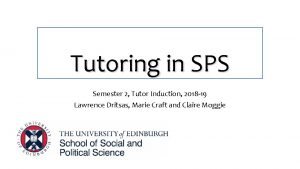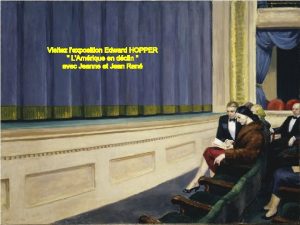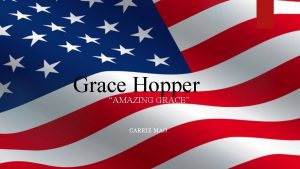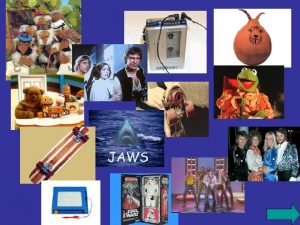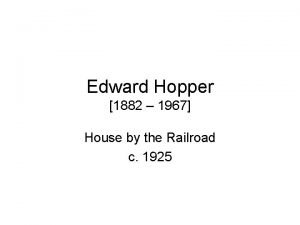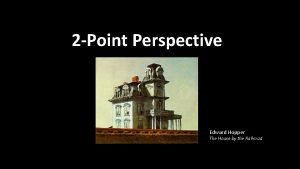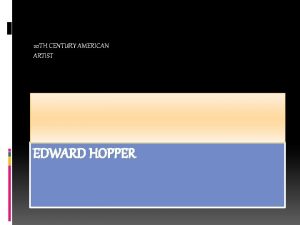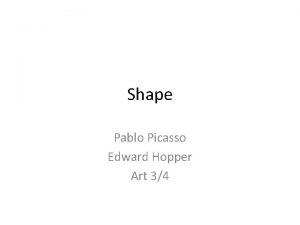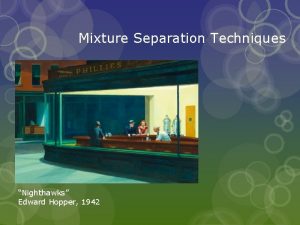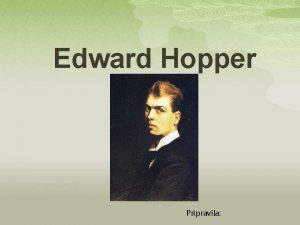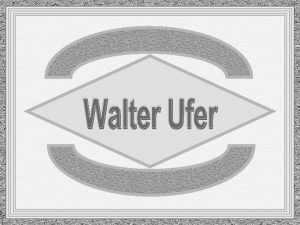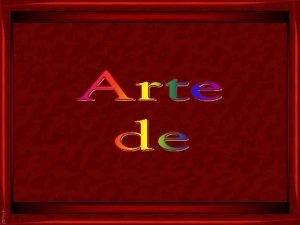Edward Hopper nasceu em 22 de julho de




































- Slides: 36


Edward Hopper nasceu em 22 de julho de 1882, em Nyack, Nova York, onde estudou ilustração numa escola de Arte Comercial de 1899 a 1900. Por volta de 1901 iniciou-se na pintura, frequentando a “New York School of Art” até 1906, sob a orientação de Robert Henri. Ao completar a sua educação formal, Hopper fez três viagens à Europa, entre 1906 e 1910, para estudar a cena emergente de Arte Europeia. Seu trabalho sofreu forte influência dos grandes pintores realistas europeus. Suas primeiras pinturas, como “Le Pavillon de Flore” (1909), foram executadas no estilo realista, e exibiam algumas das características básicas, que ele conservou ao longo de sua carreira: estilo composto em formas geométricas simples e amplas, conjunto de cores sem relevo, e o uso de cenários com elementos arquitetônicos em expressivos elementos verticais, horizontais e diagonais. Em 1925 pintou “House by the Railroad”, um marco na Arte Americana, e o advento da maturidade do seu estilo. A ênfase em contornos e ângulos ásperos e o rígido uso de luz e sombra era comum em suas obras anteriores, mas o tom - que era o tema principal da pintura - era novo: indicava uma atmosfera de isolamento universal e, por pouco, uma soturna solidão.

Hopper teve como cenários os meios urbanos e rurais, e uma visão pessoal da vida moderna americana. O artista sempre retratou a solidão com muita subjetividade em suas obras. Um de seus trabalhos mais conhecidos, “Nightawks” (1942) retrata um café 24 horas, com uns poucos fregueses taciturnos, iluminados pelo clarão impiedoso de uma luz elétrica. Embora o trabalho de Hopper se situe fora da corrente principal da abstração em moda no meio do século 20, seu estilo esquemático e simplificado foi uma das influências nas futuras apresentações artísticas e na Pop Art. Edward Hopper morreu em Nova York, em 15 de maio de 1967. Sua esposa, a pintora Josephine Nivison, que morreu dez meses depois de Hopper, doou grande parte do seu trabalho ao “Whitney Museum of American Art”. Outros trabalhos importantes estão no “Museum of Modern Art” de Nova York, no “The Des Moines Art Center” em Iowa e no “Art Institute” de Chicago. Self-Portrait, 1906

Les Pont des Arts, 1907 - Whitney Museum of American Art, Nova York

Le Pavillon de Flore, 1909 - Whitney Museum of American Art, Nova York

Soir Bleu, 1914 - Whitney Museum of American Art, New York

New York Restaurant, 1922 - Muskegon Art Museum, Michigan

Self-Portrait, 1925 - Whitney Museum of American Art, Nova York Eleven a. m. , 1926

Automat, 1927 - Des Moines Art Center

Two on the Aisle, 1927 - Toledo Museum of Art, Ohio

Chop Suey, 1929 - Barney A. Ebsworth Collection

Early Sunday Morning, 1930 - Whitney Museum of American Art, Nova York

Tables for Ladies, 1930 - Metropolitan Museum of Art

Room in New York, 1932 - Sheldon Memorial Art Gallery and Sculpture Garden, University of Nebraska

The Circle Theatre, 1936 - Private Collection

Cape Cod Evening, 1939 - National Gallery of Art, Washington, D. C.

Gas, 1940 - Museum of Modern Art

Nighthawks Home, 1942 - The Art Institute of Chicago

Dawn in Pennsylvania, 1942 - Terra Foundation for American Art, Chicago

Summertime, 1943 - Delaware Art Museum

Morning in a City, 1944 - Williams College Museum of Art

El Palacio, 1946 - Whitney Museum of American Art, Nova York

Approaching a City, 1946 - The Phillips Collection

Conference at Night, 1949 - Wichita Art Museum

First Row Orchestra, 1951 - Hirshhorn Museum and Sculpture Garden

Morning Sun, 1952 - Columbus Museum of Art

Hotel by a Railroad, 1952 - Hirshhorn Museum and Sculpture Garden

City Sunlight, 1954 - Hirshhorn Museum

Hotel Window, 1955 - The Forbes Magazine Collection

Western Motel, 1957 - Yale University Art Gallery

Excursion into Philosophy, 1959 - Private Collection

A Woman in the Sun, 1961 - Whitney Museum of American Art, Nova York

New York Office, 1962 - Museum of Fine Arts, Montgomery, Alabama

Biography: Edward Hopper was born on July 22, 1882, in Nyack, New York, where he studied illustration on a commercial art school from 1899 to 1900. Around 1901 he began to paint, attending the “New York School of Art” until 1906, under the guidance of Robert Henri. After completing his formal education, Hopper made three trips to Europe between 1906 and 1910 to study the emergent scene of European Art. His work has a strong influence of the great realist painters of Europe. His early paintings like “Le Pavillon de Flore” (1909), were executed in the realistic style, and exhibiting some of the basic features, which he retained throughout his career: style composed in simple geometric shapes and wide range of colors without relief, and the use of scenarios with significant vertical, horizontal and diagonal architectural elements. Intermission, 1963 - Private Collection In 1925 he painted “House by the Railroad”, a landmark in American Art, and the advent of his mature style. The emphasis on contours and angles harsh and rigid use of light and shadow was common in his earlier works, but the tone - that was the main theme of the painting – was new: indicated an atmosphere of isolation and a bit of universal and sullen solitude. Tue urban and rural areas and a personal vision of modern American life have always been the scenes of Hopper. The artist has always portrayed the loneliness with much subjectivity in his works. One of his most famous works, “Nightawks” (1942) portrays a 24 -hour coffee, with a few customers taciturn, illuminated by the glare of a merciless electric light. Although Hopper’s work is outside the mainstream of abstraction in fashion in the mid-20 th century, his simplified schematic style was an influence on the future of the performing arts and Pop Art Edward Hopper died in New York on May 15, 1967. His wife, painter Josephine Nivison, who died ten months after Hopper, donated much of his work to “Whitney Museum of American Art”. Other important works are in the “Museum of Modern Art” in New York, “The Des Moines Art Center” in Iowa, and the “Art Institute” of Chicago. Two Comedians, 1965 - Private Collection

Créditos Música: The Man I Love George Gershwin, 1898 -1937 Ira Gershwin, 1896 -1983 Pesquisa e Formatação: Julia Zappa juliazappa@uol. com. br Revisão: Ida Aranha sabercultural@sabercultural. com http: //www. sabercultural. org Fontes: http: //www. canvasreplicas. com/Hopper. htm http: //pt. wikipedia. org/wiki/Edward_Hopper http: //www. pintoresfamosos. com. br/? pg=hopper http: //www. artchive. com/artchive/H/hopper. html http: //www. leninimports. com/edward_hopper. html Fevereiro 2012

Chair Car, 1965 - Private Collection
 Edward hopper, morning sun
Edward hopper, morning sun Edward hopper noctámbulos
Edward hopper noctámbulos Where did edward hopper die
Where did edward hopper die Compartiment c voiture 293
Compartiment c voiture 293 18 de julho bom dia
18 de julho bom dia Esse texto foi escrito
Esse texto foi escrito Paraipaba - ceará 06 de julho de 2016. querido diário
Paraipaba - ceará 06 de julho de 2016. querido diário Julho estação do ano
Julho estação do ano Michelangelo di lodovico buonarroti simoni
Michelangelo di lodovico buonarroti simoni Poeta cantor de rua que na cidade nasceu
Poeta cantor de rua que na cidade nasceu Nasceu em paris em 1859
Nasceu em paris em 1859 Paulo freire nasceu em recife em 1921
Paulo freire nasceu em recife em 1921 Fedro fabulista
Fedro fabulista Em belem nasceu jesus nosso grande redentor
Em belem nasceu jesus nosso grande redentor Uma flor nasceu no asfalto
Uma flor nasceu no asfalto Biografia de augusto comte
Biografia de augusto comte Canto inicial
Canto inicial Onde nasceu pintor lasar segal
Onde nasceu pintor lasar segal Natal tempo de luz
Natal tempo de luz Paulo freire nasceu
Paulo freire nasceu Moodle grace hopper
Moodle grace hopper A hopper drops gravel at a rate of 75 kg
A hopper drops gravel at a rate of 75 kg Greace hopper
Greace hopper Six sigma project hopper template
Six sigma project hopper template Hopper doo
Hopper doo Mrs hopper
Mrs hopper Greace hopper
Greace hopper Darkroom equipment in radiography
Darkroom equipment in radiography Grace hopper
Grace hopper Sps tutoring
Sps tutoring Hopper and traugott 2003
Hopper and traugott 2003 R programming khan academy
R programming khan academy Abigail ross hopper
Abigail ross hopper Edward raban
Edward raban Edward 40 hands
Edward 40 hands Kenyoku ho
Kenyoku ho Edward jones organizational chart
Edward jones organizational chart
